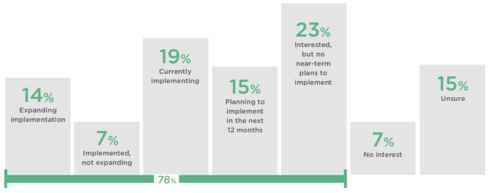
As organizations are looking to expand Agile practices throughout the entire business, they are starting to turn to value stream management (VSM). Digital.ai released the 14th annual State of Agile report, which revealed 78% of respondents are interested in VSM, planning to implement it, or in the stages of implementing it.
“We expect a greater percentage of organizations to embrace VSM going forward, as understanding increases and tooling more capably enables the unification of the ‘concept of cash’ value stream,” the report stated.
RELATED CONTENT:
What problem are we looking to solve with value stream management
D2 Emerge to launch industry’s first value stream event
2019: How the year of value stream held up
Additionally, the report found that agility is still confined to the technology side of business and in order to achieve true business agility, organizations must have effective alignment and coordination across all areas of the business.
VSM “is a combination of people, process, and technology that maps, optimizes, visualizes, measures, and governs business value flow (in the form of epics, stories, work items) through heterogeneous enterprise software delivery pipelines from idea through development and into production,” the Digital.ai team wrote in a blog post.
The report also found that organizational culture continues to be a top challenge to adopting and scaling Agile. Other challenges included resistance to change, inadequate management support and sponsorship, and not enough leadership participation.
In addition, this year’s report took a look at the impact of COVID-19 on businesses and Agile adoption. Some findings here included 55% of respondents say their company plans to increase the use of Agile; 43% say Agile adoption has increased over the last 90 days with 15% saying it increased significantly; and 33% increased or expanded Agile adoption in the last 90 days to help manage distributed teams.
Distributed Agile teams have also become the new normal as more teams are working from home. “While working face-to-face can be desirable for Agile practices, survey respondents indicated that organizations are supporting distributed teams and team members. There is no evidence of a trend toward increased co-location, as more respondents indicated their organizations continue to support and encourage team collaboration across geographic boundaries and timezones,” the team wrote.
The Scaled Agile Framework (SAFe) was also found to be the most popular scaling method followed by Scrum@Scale.
“Since the earliest days at Scaled Agile, our core belief has been simple: better software and systems make the world a better place. What has emerged during this global pandemic is confirmation that — given the right environment — remote Agile teams can be highly productive, and enterprises continue to get outstanding business benefits from applying SAFe,” said Dean Leffingwell, creator of SAFe.
Other key findings of the report included:
- Risk and compliance continue to trend upward
- There is a shift in Agile techniques with product road-mapping increasing and release planning decreasing
- 60% have increased speed to market with Agile
- Reasons for adopting agile include: accelerate software delivery, enhance ability to manage changing priorities, and achieve increased productivity.
- Recommended Agile project management tools include: Atlassian Jira, VersionOne, Jira Align, LeanKit, Target Process and Microsoft Azure DevOps
The Agile report was conducted from August to December of 2019 with an updated COVID-19 questionnaire conducted in May of 2020.






